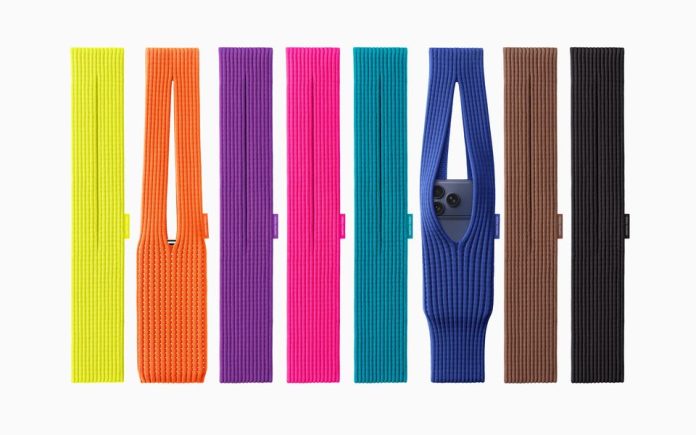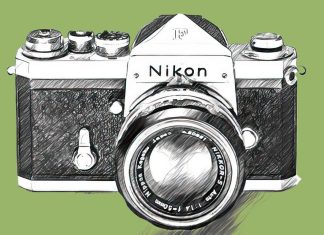
An undated promotional image from Apple of color options for the new iPhone Pocket. Decades after their founders connected, Apple and Issey Miyake released a collection of phone pouches that have some people baffled. [Apple via The New York Times]
It was a meeting of the minds.
In 1981, when Steve Jobs, the founder of Apple, met Issey Miyake, a Japanese designer, the two connected on the power of functional dressing. Jobs, inspired by the uniforms Miyake designed for Sony employees, commissioned the designer to create similar attire for his team in Cupertino. The idea got him “booed off,” Jobs told his biographer Walter Isaacson.
That didn’t stop the men from working together. Miyake created the black mock turtleneck Jobs adopted as part of his uniform, which he completed with blue Levi’s 501s and New Balance sneakers. The relaxed outfit shaped what the public came to expect from tech leaders’ style choices.
The two men’s companies never formally collaborated during their lifetimes. But now, four decades later, they have.
In a buzzed-about collaboration that has drawn a range of reactions, Apple and Issey Miyake joined forces to introduce an accessory inspired by Miyake’s “A Piece of Cloth” project, which uses modern technology to create garments that require the person wearing them to think creatively about how it might affect them and their lives. The result: a long fabric pouch for your phone that is called the iPhone Pocket.
The product, which was released Friday, is a ribbed, vividly hued knit pouch designed to hold a cellphone. As it expands, the mesh paneling underneath the fabric also allows it to hold other accouterments. It can be worn cross-body or attached to a handbag strap, dangling like a charm. Its ribbed texture takes inspiration from Issey Miyake’s popular Pleats Please line.
The partnership came “naturally,” Yoshiyuki Miyamae, the design director of Miyake Design Studio, Issey Miyake’s parent company, said in an interview. It was a result of the brands sharing what they had learned about design over a few years.
“When we first met each other, of course, we talked about, you know, Miyake and Mr Jobs,” Miyamae said via a translator. “We discussed how, as the next generation of designers, do we continue their philosophy and how do we continue to maintain the same design spirit and design approach.”
This move is Apple’s latest in the fashion realm. The brand has collaborated with Hermès, the French luxury house and maker of the Birkin bag, for the last decade, creating watch bands as well as holders for its AirTags. These tie-ups are part of a growing trend as more tech and fashion brands lean on one another. Meta has been in partnership with EssilorLuxottica, the parent company of Ray-Ban and Oakley, since 2019, introducing a slew of smart glasses. Other labels, including Chanel and Sandy Liang, have found a way to tap into the tech consumer.
“We’re using tech every day, you know, it does sort of become a piece of fashion,” said Justine Ezarik, a YouTube creator also known as iJustine, who reviews tech products. “It’s smart on both parts, for the higher-end fashion brands and especially Apple, to do that, because there seems to be a market for that.”
The iPhone Pocket immediately recalled the company’s somewhat infamous iPod Socks – the brightly colored, two-toned pouches that were released in 2004. Despite being initially dismissed as a joke by consumers, the iPod Socks gained a following, partly as a result of their price point ($29 for six pairs at launch). Consumers like Ezarik procured them secondhand when Apple discontinued them in 2012.
Reactions to the iPhone Pocket on social media thus far have ranged from excitement to confusion. Miyamae is aware that the product may not be readily understandable by consumers, but, he said, neither are standard Issey Miyake designs.
“Design should be leaving things a little bit less defined to allow more creativity from the user side,” he said. “If maybe you’re given a Issey Miyake garment, at first you have no idea how to wear it, but you know as you wear it in your own way.”
Much of the reaction, however, has expressed skepticism about how widely adopted the iPhone Pocket will be. While phone wrist-straps have grown in popularity in the United States, cross-body straps have not gained as much of a foothold among American consumers as they have with shoppers based in Asia and Western Europe. Additionally, the price may be a deterrent. The shorter-strapped pouches retail for $149.95, while the long-strap design costs $229.95.
“I don’t know if, like, the US is ready for this sort of thing,” Ezarik said, noting that the tide may change as cellphone sizes outgrow the standard back pocket and that it would make “so much sense” to be hands-free.
This article originally appeared in The New York Times.







